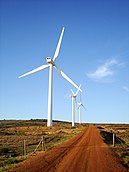
A | B | C | D | E | F | G | H | CH | I | J | K | L | M | N | O | P | Q | R | S | T | U | V | W | X | Y | Z | 0 | 1 | 2 | 3 | 4 | 5 | 6 | 7 | 8 | 9
| Part of a series on |
| Sustainable energy |
|---|
 |
Renewable energy (or green energy) is energy from renewable natural resources that are replenished on a human timescale. Using renewable energy technologies helps with climate change mitigation, energy security, and also has some economic benefits.[1] Commonly used renewable energy types include solar energy, wind power, hydropower, bioenergy and geothermal power. Renewable energy installations can be large or small. They are suited for urban as well as rural areas. Renewable energy is often deployed together with further electrification. This has several benefits: electricity can move heat and vehicles efficiently, and is clean at the point of consumption.[2][3] Variable renewable energy sources are those that have a fluctuating nature, such as wind power and solar power. In contrast, controllable renewable energy sources include dammed hydroelectricity, bioenergy, or geothermal power.
Renewable energy systems are rapidly becoming more efficient and cheaper. As a result, their share of global energy consumption is increasing.[4] A large majority of worldwide newly installed electricity capacity is now renewable.[5] In most countries, photovoltaic solar or onshore wind are the cheapest new-build electricity.[6] Renewable energy can help reduce energy poverty in rural and remote areas of developing countries, where lack of energy access is often hindering economic development. Renewable energy resources exist all over the world. This is in contrast to fossil fuels resources which are concentrated in a limited number of countries.
There are also other renewable energy technologies that are still under development, for example enhanced geothermal systems, concentrated solar power, cellulosic ethanol, and marine energy.[7][8]
From 2011 to 2021, renewable energy grew from 20% to 28% of global electricity supply. Use of fossil energy shrank from 68% to 62%, and nuclear from 12% to 10%. The share of hydropower decreased from 16% to 15% while power from sun and wind increased from 2% to 10%. Biomass and geothermal energy grew from 2% to 3%.[9][10] In 2022, renewables accounted for 30% of global electricity generation, up from 21% in 1985, and projected to reach over 42% by 2028.[11][12]
Many countries around the world already have renewable energy contributing more than 20% of their total energy supply. Some countries generate over half their electricity from renewables.[13] A few countries generate all their electricity from renewable energy.[14] National renewable energy markets are projected to continue to grow strongly in the 2020s and beyond.[15]
The deployment of renewable energy is being hindered by massive fossil fuel subsidies.[16] In 2022 the International Energy Agency (IEA) requested all countries to reduce their policy, regulatory, permitting and financing obstacles for renewables.[17] This would increase the chances of the world reaching net zero carbon emissions by 2050.[17] According to the IEA, to achieve net zero emissions by 2050, 90% of global electricity generation will need to be produced from renewable sources.[18]
Whether nuclear power is renewable energy or not is still controversial. There are also debates around geopolitics, the metal and mineral extraction needed for solar panels and batteries, possible installations in conservation areas and the need to recycle solar panels. Although most renewable energy sources are sustainable, some are not. For example, some biomass sources are unsustainable at current rates of exploitation.[19]
Overview


Definition
Renewable energy is usually understood as energy harnessed from continuously occurring natural phenomena. The International Energy Agency defines it as "energy derived from natural processes that are replenished at a faster rate than they are consumed". Solar power, wind power, hydroelectricity, geothermal energy, and biomass are widely agreed to be the main types of renewable energy.[22] Renewable energy often displaces conventional fuels in four areas: electricity generation, hot water/space heating, transportation, and rural (off-grid) energy services.[23]
Although almost all forms of renewable energy cause much fewer carbon emissions than fossil fuels, the term is not synonymous with low-carbon energy. Some non-renewable sources of energy, such as nuclear power,[contradictory]generate almost no emissions, while some renewable energy sources can be very carbon-intensive, such as the burning of biomass if it is not offset by planting new plants.[24] Renewable energy is also distinct from sustainable energy, a more abstract concept that seeks to group energy sources based on their overall permanent impact on future generations of humans. For example, biomass is often associated with unsustainable deforestation.[25]
Role in addressing climate change
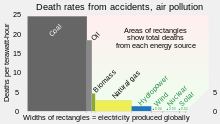
As part of the global effort to limit climate change, most countries have committed to net zero greenhouse gas emissions.[27] In practice, this means phasing out fossil fuels and replacing them with low-emissions energy sources.[24] At the 2023 United Nations Climate Change Conference, around three-quarters of the world's countries set a goal of tripling renewable energy capacity by 2030.[28] The European Union aims to generate 40% of its electricity from renewables by the same year.[29]
Renewable energy is also more evenly distributed around the world than fossil fuels, which are concentrated in a limited number of countries.[30] It also brings health benefits by reducing air pollution caused by the burning of fossil fuels. The potential worldwide savings in health care costs have been estimated at trillions of dollars annually.[31]
Other benefits
Moving to modern renewable energy has very large health benefits due to reducing air pollution from fossil fuels.[32][33][34]
Intermittency

The two most important forms of renewable energy, solar and wind, are intermittent energy sources: they are not available constantly. In contrast, fossil fuel power plants are usually able to produce precisely the amount of energy an electricity grid requires at a given time. Solar energy can only be captured during the day, and ideally in cloudless conditions. Wind power generation can vary significantly not only day-to-day, but even month-to-month.[35] This poses a challenge when transitioning away from fossil fuels: energy demand will often be higher or lower than what renewables can provide.[36] Both scenarios can cause electricity grids to become overloaded, leading to power outages.
Energy storage is an important way of dealing with this variability.[37] Implementation of energy storage, using a wide variety of renewable energy technologies, and implementing a smart grid can reduce risks and costs of renewable energy implementation.[38]
Sector coupling of the power generation sector with other sectors may increase flexibility: for example the transport sector can be coupled by charging electric vehicles and sending electricity from vehicle to grid.[39] Similarly the industry sector can be coupled by hydrogen produced by electrolysis,[40] and the buildings sector by thermal energy storage for space heating and cooling.[41]
Electrical energy storage
Electrical energy storage is a collection of methods used to store electrical energy. Electrical energy is stored during times when production (especially from intermittent sources such as wind power, tidal power, solar power) exceeds consumption, and returned to the grid when production falls below consumption. Pumped-storage hydroelectricity accounts for more than 85% of all grid power storage.[42] Batteries are increasingly being deployed for storage[43] and grid ancillary services[44] and for domestic storage.[45] Green hydrogen is a more economical means of long-term renewable energy storage, in terms of capital expenditures compared to pumped hydroelectric or batteries.[46][47]
Mainstream technologies

Solar energy
| Installed capacity and other key design parameters | Value and year |
| Global electricity power generation capacity | 1419.0 GW (2023)[49] |
| Global electricity power generation capacity annual growth rate | 25% (2014-2023)[50] |
| Share of global electricity generation | 5.5% (2023)[51] |
| Levelized cost per megawatt hour | Utility-scale photovoltaics: USD 38.343 (2019)[52] |
| Primary technologies | Photovoltaics, concentrated solar power, solar thermal collector |
| Main applications | Electricity, water heating, heating, ventilation, air conditioning (HVAC) |


Solar power produced around 1.3 terrawatt-hours (TWh) worldwide in 2022,[13] representing 4.6% of the world's electricity. Almost all of this growth has happened since 2010.[53] Solar energy can be harnessed anywhere that receives sunlight; however, the amount of solar energy that can be harnessed for electricity generation is influenced by weather conditions, geographic location and time of day.[54]
There are two mainstream ways of harnessing solar energy: solar thermal, which converts solar energy into heat; and photovoltaics (PV), which converts it into electricity.[24] PV is far more widespread, accounting for around two thirds of the global solar energy capacity as of 2022.[55] It is also growing at a much faster rate, with 170 GW newly installed capacity in 2021,[56] compared to 25 GW of solar thermal.[55]
Passive solar refers to a range of construction strategies and technologies that aim to optimize the distribution of solar heat in a building. Examples include solar chimneys,[24] orienting a building to the sun, using construction materials that can store heat, and designing spaces that naturally circulate air.[57]
From 2020 to 2022, solar technology investments almost doubled from USD 162 billion to USD 308 billion, driven by the sector's increasing maturity and cost reductions, particularly in solar photovoltaic (PV), which accounted for 90% of total investments. China and the United States were the main recipients, collectively making up about half of all solar investments since 2013. Despite reductions in Japan and India due to policy changes and COVID-19, growth in China, the United States, and a significant increase from Vietnam's feed-in tariff program offset these declines. Globally, the solar sector added 714 gigawatts (GW) of solar PV and concentrated solar power (CSP) capacity between 2013 and 2021, with a notable rise in large-scale solar heating installations in 2021, especially in China, Europe, Turkey, and Mexico.[58]
Photovoltaics
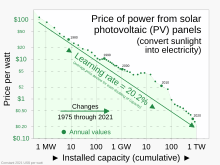
A photovoltaic system, consisting of solar cells assembled into panels, converts light into electrical direct current via the photoelectric effect.[61] PV has several advantages that make it by far the fastest-growing renewable energy technology. It is cheap, low-maintenance and scalable; adding to an existing PV installation as demanded arises is simple. Its main disadvantage is its poor performance in cloudy weather.[24]
PV systems range from small, residential and commercial rooftop or building integrated installations, to large utility-scale photovoltaic power station.[62] A household's solar panels can either be used for just that household or, if connected to an electrical grid, can be aggregated with millions of others.[63]
The first utility-scale solar power plant was built in 1982 in Hesperia, California by ARCO.[64] The plant was not profitable and was sold eight years later.[65] However, over the following decades, PV cells became significantly more efficient and cheaper.[66] As a result, PV adoption has grown exponentially since 2010.[67] Global capacity increased from 230 GW at the end of 2015 to 890 GW in 2021.[68] PV grew fastest in China between 2016 and 2021, adding 560 GW, more than all advanced economies combined.[69] Four of the ten biggest solar power stations are in China, including the biggest, Golmud Solar Park in China.[70]
Solar thermal
Unlike photovoltaic cells that convert sunlight directly into electricity, solar thermal systems convert it into heat. They use mirrors or lenses to concentrate sunlight onto a receiver, which in turn heats a water reservoir. The heated water can then be used in homes. The advantage of solar thermal is that the heated water can be stored until it is needed, eliminating the need for a separate energy storage system.[71] Solar thermal power can also be converted to electricity by using the steam generated from the heated water to drive a turbine connected to a generator. However, because generating electricity this way is much more expensive than photovoltaic power plants, there are very few in use today.[72]
Wind power

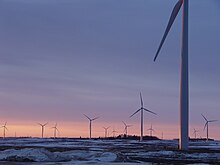

| Installed capacity and other key design parameters | Value and year |
| Global electricity power generation capacity | 1017.2 GW (2023)[74] |
| Global electricity power generation capacity annual growth rate | 13% (2014-2023)[75] |
| Share of global electricity generation | 7.8% (2023)[51] |
| Levelized cost per megawatt hour | Land-based wind: USD 30.165 (2019)[76] |
| Primary technology | Wind turbine, windmill |
| Main applications | Electricity, pumping water (windpump) |
Humans have harnessed wind energy since at least 3500 BC. Until the 20th century, it was primarily used to power ships, windmills and water pumps. Today, the vast majority of wind power is used to generate electricity using wind turbines.[24] Modern utility-scale wind turbines range from around 600 kW to 9 MW of rated power. The power available from the wind is a function of the cube of the wind speed, so as wind speed increases, power output increases up to the maximum output for the particular turbine.[77] Areas where winds are stronger and more constant, such as offshore and high-altitude sites, are preferred locations for wind farms.
Wind-generated electricity met nearly 4% of global electricity demand in 2015, with nearly 63 GW of new wind power capacity installed. Wind energy was the leading source of new capacity in Europe, the US and Canada, and the second largest in China. In Denmark, wind energy met more than 40% of its electricity demand while Ireland, Portugal and Spain each met nearly 20%.[78]
Globally, the long-term technical potential of wind energy is believed to be five times total current global energy production, or 40 times current electricity demand, assuming all practical barriers needed were overcome. This would require wind turbines to be installed over large areas, particularly in areas of higher wind resources, such as offshore, and likely also industrial use of new types of VAWT turbines in addition to the horizontal axis units currently in use. As offshore wind speeds average ~90% greater than that of land, offshore resources can contribute substantially more energy than land-stationed turbines.[79]
Investments in wind technologies reached USD 161 billion in 2020, with onshore wind dominating at 80% of total investments from 2013 to 2022. Offshore wind investments nearly doubled to USD 41 billion between 2019 and 2020, primarily due to policy incentives in China and expansion in Europe. Global wind capacity increased by 557 GW between 2013 and 2021, with capacity additions increasing by an average of 19% each year.[58]
Hydropower
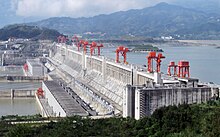
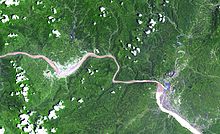
| Installed capacity and other key design parameters | Value and year |
| Global electricity power generation capacity | 1,267.9 GW (2023)[80] |
| Global electricity power generation capacity annual growth rate | 1.9% (2014-2023)[81] |
| Share of global electricity generation | 14.3% (2023)[51] |
| Levelized cost per megawatt hour | USD 65.581 (2019)[82] |
| Primary technology | Dam |
| Main applications | Electricity, pumped storage, mechanical power |
Since water is about 800 times denser than air, even a slow flowing stream of water, or moderate sea swell, can yield considerable amounts of energy. Water can generate electricity with a conversion efficiency of about 90%, which is the highest rate in renewable energy.[83] There are many forms of water energy:
- Historically, hydroelectric power came from constructing large hydroelectric dams and reservoirs, which are still popular in developing countries.[84] The largest of them are the Three Gorges Dam (2003) in China and the Itaipu Dam (1984) built by Brazil and Paraguay.
- Small hydro systems are hydroelectric power installations that typically produce up to 50 MW of power. They are often used on small rivers or as a low-impact development on larger rivers. China is the largest producer of hydroelectricity in the world and has more than 45,000 small hydro installations.[85]
- Run-of-the-river hydroelectricity plants derive energy from rivers without the creation of a large reservoir. The water is typically conveyed along the side of the river valley (using channels, pipes and/or tunnels) until it is high above the valley floor, whereupon it can be allowed to fall through a penstock to drive a turbine. A run-of-river plant may still produce a large amount of electricity, such as the Chief Joseph Dam on the Columbia River in the United States.[86] However many run-of-the-river hydro power plants are micro hydro or pico hydro plants.
Much hydropower is flexible, thus complementing wind and solar.[87] In 2021, the world renewable hydropower capacity was 1,360 GW.[69] Only a third of the world's estimated hydroelectric potential of 14,000 TWh/year has been developed.[88][89] New hydropower projects face opposition from local communities due to their large impact, including relocation of communities and flooding of wildlife habitats and farming land.[90] High cost and lead times from permission process, including environmental and risk assessments, with lack of environmental and social acceptance are therefore the primary challenges for new developments.[91] It is popular to repower old dams thereby increasing their efficiency and capacity as well as quicker responsiveness on the grid.[92] Where circumstances permit existing dams such as the Russell Dam built in 1985 may be updated with "pump back" facilities for pumped-storage which is useful for peak loads or to support intermittent wind and solar power. Because dispatchable power is more valuable than VRE[93][94] countries with large hydroelectric developments such as Canada and Norway are spending billions to expand their grids to trade with neighboring countries having limited hydro.[95]
Bioenergy
| Installed capacity and other key design parameters | Value and year |
| Global electricity power generation capacity | 150.3 GW (2023)[96] |
| Global electricity power generation capacity annual growth rate | 5.8% (2014-2023)[97] |
| Share of global electricity generation | 2.4% (2022)[51] |
| Levelized cost per megawatt hour | USD 118.908 (2019)[98] |
| Primary technologies | Biomass, biofuel |
| Main applications | Electricity, heating, cooking, transportation fuels |
Biomass is biological material derived from living, or recently living organisms. Most commonly, it refers to plants or plant-derived materials. As an energy source, biomass can either be used directly via combustion to produce heat, or converted to a more energy-dense biofuel like ethanol. Wood is the most significant biomass energy source as of 2012[99] and is usually sourced from a trees cleared for silvicultural reasons or fire prevention. Municipal wood waste – for instance, construction materials or sawdust – is also often burned for energy.[100] The biggest per-capita producers of wood-based bioenergy are heavily forested countries like Finland, Sweden, Estonia, Austria, and Denmark.[101]
Bioenergy can be environmentally destructive if old-growth forests are cleared to make way for crop production. In particular, demand for palm oil to produce biodiesel has contributed to the deforestation of tropical rainforests in Brazil and Indonesia.[102] In addition, burning biomass still produces carbon emissions, although much less than fossil fuels (39 grams of CO2 per megajoule of energy, compared to 75 g/MJ for fossil fuels).[103]
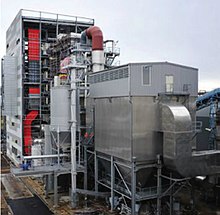
Biofuel
Biofuels are primarily used in transportation, providing 3.5% of the world's transport energy demand in 2022,[104] up from 2.7% in 2010.[105] Biojet is expected to be important for short-term reduction of carbon dioxide emissions from long-haul flights.[106]
Aside from wood, the major sources of bioenergy are bioethanol and biodiesel.[24] Bioethanol is usually produced by fermenting the sugar components of crops like sugarcane and maize, while biodiesel is mostly made from oils extracted from plans, such as soybean oil and corn oil.[107] Most of the crops used to produce bioethanol and biodiesel are grown specifically for this purpose,[108] although used cooking oil accounted for 14% of the oil used to produce biodiesel as of 2015.[107] The biomass used to produce biofuels varies by region. Maize is the major feedstock in the United States, while sugarcane dominates in Brazil.[109] In the European Union, where biodiesel is more common than bioethanol, rapeseed oil and palm oil are the main feedstocks.[110] China, although it produces comparatively much less biofuel, uses mostly corn and wheat.[111] In many countries, biofuels are either subsidized or mandated to be included in fuel mixtures.[102]

There are many other sources of bioenergy that are more niche, or not yet viable at large scales. For instance, bioethanol could be produced from the cellulosic parts of crops, rather than only the seed as is common today.[112] Sweet sorghum may be a promising alternative source of bioethanol, due to its tolerance of a wide range of climates.[113] Cow dung can be converted into methane.[114] There is also a great deal of research involving algal fuel, which is attractive because algae is a non-food resource, grows around 20 times faster than most food crops, and can be grown almost anywhere.[115]

Geothermal energy
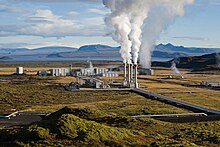

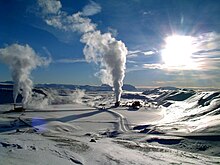
| Installed capacity and other key design parameters | Value and year |
| Global electricity power generation capacity | 14.9 GW (2023)[116] |
| Global electricity power generation capacity annual growth rate | 3.4% (2014-2023)[117] |
| Share of global electricity generation | <1% (2018)[118] |
| Levelized cost per megawatt hour | USD 58.257 (2019)[119] |
| Primary technologies | Dry steam, flash steam, and binary cycle power stations |
| Main applications | Electricity, heating |
Geothermal energy is thermal energy (heat) extracted from the Earth's crust. It originates from several different sources, of which the most significant is slow radioactive decay of minerals contained in the Earth's interior,[24] as well as some leftover heat from the formation of the Earth.[120] Some of the heat is generated near the Earth's surface in the crust, but some also flows from deep within the Earth from the mantle and core.[120] Geothermal energy extraction is viable mostly in countries located on tectonic plate edges, where the Earth's hot mantle is more exposed.[121] As of 2023, the United States has by far the most geothermal capacity (2.7 GW,[122] or less than 0.2% of the country's total energy capacity[123]), followed by Indonesia and the Philippines. Global capacity in 2022 was 15 GW.[122]
Geothermal energy can be either used directly to heat homes, as is common in Iceland, or to generate electricity. At smaller scales, geothermal power can be generated with geothermal heat pumps, which can extract heat from ground temperatures of under 30 °C (86 °F), allowing them to be used at relatively shallow depths of a few meters.[121] Electricity generation requires large plants and ground temperatures of at least 150 °C (302 °F). In some countries, electricity produced from geothermal energy accounts for a large portion of the total, such as Kenya (43%) and Indonesia (5%).[124]
Technical advances may eventually make geothermal power more widely available. For example, enhanced geothermal systems involve drilling around 10 kilometres (6.2 mi) into the Earth, breaking apart hot rocks and extracting the heat using water. In theory, this type of geothermal energy extraction could be done anywhere on Earth.[121]
Emerging technologies
There are also other renewable energy technologies that are still under development, including enhanced geothermal systems, concentrated solar power, cellulosic ethanol, and marine energy.[7][8] These technologies are not yet widely demonstrated or have limited commercialization. Many are on the horizon and may have potential comparable to other renewable energy technologies, but still depend on attracting sufficient attention and research, development and demonstration (RD&D) funding.[8]
There are numerous organizations within the academic, federal,[clarification needed] and commercial sectors conducting large-scale advanced research in the field of renewable energy. This research spans several areas of focus across the renewable energy spectrum. Most of the research is targeted at improving efficiency and increasing overall energy yields.[125] Multiple government-supported research organizations have focused on renewable energy in recent years. Two of the most prominent of these labs are Sandia National Laboratories and the National Renewable Energy Laboratory (NREL), both of which are funded by the United States Department of Energy and supported by various corporate partners.[126]
Enhanced geothermal systems
Enhanced geothermal systems (EGS) are a new type of geothermal power which does not require natural hot water reservoirs or steam to generate power. Most of the underground heat within drilling reach is trapped in solid rocks, not in water.[127] EGS technologies use hydraulic fracturing to break apart these rocks and release the heat they contain, which is then harvested by pumping water into the ground. The process is sometimes known as "hot dry rock" (HDR).[128] Unlike conventional geothermal energy extraction, EGS may be feasible anywhere in the world, depending on the cost of drilling.[129] EGS projects have so far primarily been limited to demonstration plants, as the technology is capital-intensive due to the high cost of drilling.[130]
Marine energy

Marine energy (also sometimes referred to as ocean energy) is the energy carried by ocean waves, tides, salinity, and ocean temperature differences. Technologies to harness the energy of moving water include wave power, marine current power, and tidal power. Reverse electrodialysis (RED) is a technology for generating electricity by mixing fresh water and salty sea water in large power cells.[131][page needed] Most marine energy harvesting technologies are still at low technology readiness levels and not used at large scales. Tidal energy is generally considered the most mature, but has not seen wide deployment.[132] The world's largest tidal power station is on Sihwa Lake, South Korea,[133] which produces around 550 gigawatt-hours of electricity per year.[134]
Earth infrared thermal radiation
Earth emits roughly 1017 W of infrared thermal radiation that flows toward the cold outer space. Solar energy hits the surface and atmosphere of the earth and produces heat. Using various theorized devices like emissive energy harvester (EEH) or thermoradiative diode, this energy flow can be converted into electricity. In theory, this technology can be used during nighttime.[135][136]
Others
Algae fuels
Producing liquid fuels from oil-rich (fat-rich) varieties of algae is an ongoing research topic. Various microalgae grown in open or closed systems are being tried including some systems that can be set up in brownfield and desert lands.[137]
Water vapor
Collection of static electricity charges from water droplets on metal surfaces is an experimental technology that would be especially useful in low-income countries with relative air humidity over 60%.[138]
Nuclear energy
Breeder reactors could, in principle, extract almost all of the energy contained in uranium or thorium, decreasing fuel requirements by a factor of 100 compared to widely used once-through light water reactors, which extract less than 1% of the energy in the actinide metal (uranium or thorium) mined from the earth.[139] The high fuel-efficiency of breeder reactors could greatly reduce concerns about fuel supply, energy used in mining, and storage of radioactive waste. With seawater uranium extraction (currently too expensive to be economical), there is enough fuel for breeder reactors to satisfy the world's energy needs for 5 billion years at 1983's total energy consumption rate, thus making nuclear energy effectively a renewable energy.[140][141] In addition to seawater the average crustal granite rocks contain significant quantities of uranium and thorium that with breeder reactors can supply abundant energy for the remaining lifespan of the sun on the main sequence of stellar evolution.[142]
Artificial photosynthesisedit
Artificial photosynthesis uses techniques including nanotechnology to store solar electromagnetic energy in chemical bonds by splitting water to produce hydrogen and then using carbon dioxide to make methanol.[143] Researchers in this field strived to design molecular mimics of photosynthesis that use a wider region of the solar spectrum, employ catalytic systems made from abundant, inexpensive materials that are robust, readily repaired, non-toxic, stable in a variety of environmental conditions and perform more efficiently allowing a greater proportion of photon energy to end up in the storage compounds, i.e., carbohydrates (rather than building and sustaining living cells).[144] However, prominent research faces hurdles, Sun Catalytix a MIT spin-off stopped scaling up their prototype fuel-cell in 2012 because it offers few savings over other ways to make hydrogen from sunlight.[145]
Consumption by sectoredit
One of the efforts to decarbonize transportation is the increased use of electric vehicles (EVs).[146] Despite that and the use of biofuels, such as biojet, less than 4% of transport energy is from renewables.[147] Occasionally hydrogen fuel cells are used for heavy transport.[148] Meanwhile, in the future electrofuels may also play a greater role in decarbonizing hard-to-abate sectors like aviation and maritime shipping.[149]
Solar water heating makes an important contribution to renewable heat in many countries, most notably in China, which now has 70% of the global total (180 GWth). Most of these systems are installed on multi-family apartment buildings[150] and meet a portion of the hot water needs of an estimated 50–60 million households in China. Worldwide, total installed solar water heating systems meet a portion of the water heating needs of over 70 million households.
Heat pumps provide both heating and cooling, and also flatten the electric demand curve and are thus an increasing priority.[151] Renewable thermal energy is also growing rapidly.[152] About 10% of heating and cooling energy is from renewables.[153]
Some studies say that a global transition to 100% renewable energy across all sectors – power, heat, transport and industry – is feasible and economically viable.[154][155][156]
Market and industry trendsedit
Most new renewables are solar, followed by wind then hydro then bioenergy.[157] Investment in renewables, especially solar, tends to be more effective in creating jobs than coal, gas or oil.[158][159] Worldwide, renewables employ about 12 million people as of 2020, with solar PV being the technology employing the most at almost 4 million.[160] However, as of February 2024, the world's supply of workforce for solar energy is lagging greatly behind demand as universities worldwide still produce more workforce for fossil fuels than for renewable energy industries.[161]
In 2021, China accounted for almost half of the global increase in renewable electricity.[162]
There are 3,146 gigawatts installed in 135 countries, while 156 countries have laws regulating the renewable energy sector.[9][10]
Globally in 2020 there are over 10 million jobs associated with the renewable energy industries, with solar photovoltaics being the largest renewable employer.[163] The clean energy sectors added about 4.7 million jobs globally between 2019 and 2022, totaling 35 million jobs by 2022.[164]: 5
Cost comparisonedit
The International Renewable Energy Agency (IRENA) stated that ~86% (187 GW) of renewable capacity added in 2022 had lower costs than electricity generated from fossil fuels.[165] IRENA also stated that capacity added since 2000 reduced electricity bills in 2022 by at least $520 billion, and that in non-OECD countries, the lifetime savings of 2022 capacity additions will reduce costs by up to $580 billion.[165]


